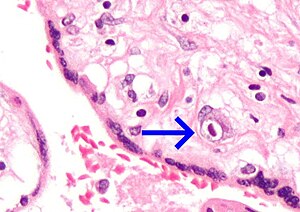Vertically transmitted infection
| Vertically transmitted infection | |
|---|---|
 |
|
| Micrograph of cytomegalovirus (CMV) infection of the placenta (CMV placentitis), a vertically transmitted infection: The characteristic large nucleus of a CMV-infected cell is seen off-centre at the bottom-right of the image, H&E stain. | |
| Classification and external resources | |
| Specialty | pediatrics |
| ICD-10 | P35-P39 |
| ICD-9-CM | 771 |
A vertically transmitted infection is an infection caused by pathogens (such as bacteria and viruses) that uses mother-to-child transmission, that is, transmission directly from the mother to an embryo, fetus, or baby during pregnancy or childbirth. It can occur when the mother gets an infection as an intercurrent disease in pregnancy. Nutritional deficiencies may exacerbate the risks of perinatal infection.
A vertically transmitted infection can be called a perinatal infection if it is transmitted in the perinatal period, which is the period starting at a gestational age of 22 weeks to 28 (with regional variations in the definition) and ending seven completed days after birth.
The term congenital infection can be used if the vertically transmitted infection persists after childbirth.
Bacteria, viruses, and other organisms are able to be passed from mother to child. Several vertically transmitted infections are included in the TORCH complex, which stands for:
The "other agents" under O include:
Hepatitis B may also be classified as a vertically transmitted infection, but the hepatitis B virus is a large virus and does not cross the placenta, hence it cannot infect the fetus unless breaks in the maternal-fetal barrier have occurred, such as can occur in bleeding during childbirth or amniocentesis.
The TORCH complex was originally considered to consist of the four conditions mentioned above, with the "TO" referring to Toxoplasma. The four-term form is still used in many modern references, and the capitalization "ToRCH" is sometimes used in these contexts. The acronym has also been listed as TORCHES, for TOxoplasmosis, Rubella, Cytomegalovirus, HErpes simplex, and Syphilis.
...
Wikipedia
